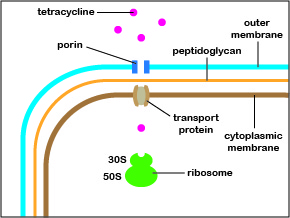
Think-Pair-Share Questions
In order for any of the tetracycline group of antibiotics to inhibit Gram-negative bacterial growth, they must enter the cytoplasm of that bacterium and bind to the 30S subunit of its ribosomes.

Earlier we learned the composition and functions of both the Gram-negative cell wall and the cytoplasmic membrane. We have also previously learned how the order of deoxyribonucleotide bases in DNA determines the order of ribonucleotide bases in rRNA which, in turn, determines the 3-dimensional shape of that RNA. Likewise, the order of deoxyribonucleotide bases in DNA determines the order of amino acids in a protein or enzyme which determines the 3-dimensional shape of that protein.
Considering all of this and using the illustration above, think of three physical changes that could occur within the bacterium as a result of acquiring new or altered genes through mutation or horizontal gene transfer that could enable the bacterium to resist that tetracycline.